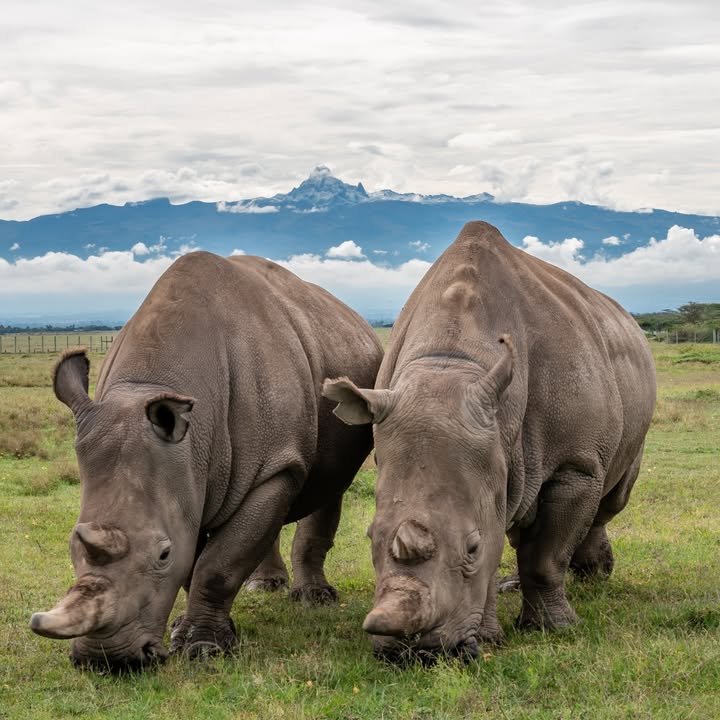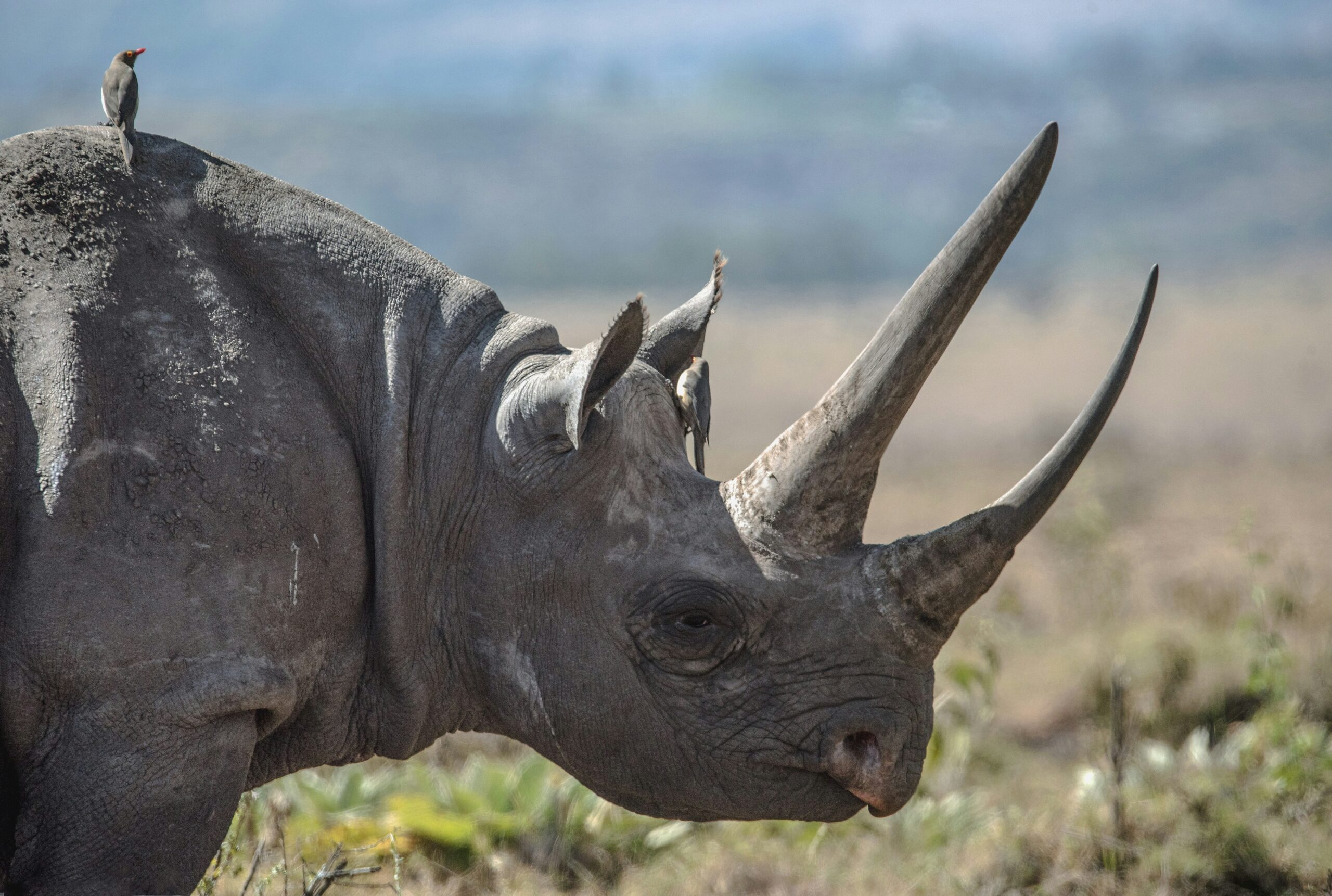The rhino is indeed the titan of the animal kingdom and one of the most famous big five in the wild. Characterized by their massive size, remarkable physical attributes and their most distinctive feature, their horns; rhinos are the second largest mammals on land after the majestic elephants. Spotting these majestic creatures in the wild is a prized experience for safari-goers – especially as they are critically endangered.
The white rhinoceros of Africa, scientifically known as Ceratotherium simum, can be divided into two subspecies: the northern white rhinoceros Ceratotherium simum cottoni and the southern white rhinoceros Ceratotherium simum simum.
Fun Facts about the White Rhino
Rhinos are actually grey

On the contrary both southern and northern white rhinos are grey in color. Regardless of their common names, all species of rhinoceros have skin that is predominantly grey. The shades might vary slightly, but you won’t find a truly white or black rhino. White rhinos aren’t actually white; the name white was derived from the German word weid meaning “wide”.
Their wide mouth indicates their feeding habits. White rhinos are grazers, meaning they primarily feed on grasses. Their broad, square lips are perfectly adapted for efficiently cropping large quantities of grass.
Rhinos have a Poor vison
Despite being a strong and large animal, Rhinos have poor eye sight. They cannot see miles away but they have a very good sense of smell and hearing from a distance and can therefore identify possible threats coming their way.
Size and aggressiveness
White rhinos are known to be the second largest land mammals in the wild, second after elephants and are surprisingly agile and can run very fast. Rhinos have a serene appearance and when they feel cornered or sense danger they can turn violent. They charge at a rate of thirty miles per hour. White rhinos are semi-social and territorial, they graze together in herds and mark their territories with dung. White rhinos encompass a lot of land due to their large size.
Lifespan of the white Rhino
Nearly 99% of the white rhino live in the savannah grasslands of Kenya. Though the vast majority live in south Africa. Rhinos can live up to 35 years in the wild and 40 in captivity. However, the northern white rhino is nearly extinct. The last male northern white rhino died in 2018 at the Ol Pejeta Conservancy. There are only two northern female white rhinos left, a mother-daughter pair at the conservancy.
How do rhinos communicate?
Interestingly, Rhinos can communicate through their dung which has unique smell due to consumption of a lot of grass. Each rhinos unique smell contains a lot of nuance that tell rhinos a lot about each other.
Difference between the northern and southern white rhino
The southern white rhino and the northern white rhino are all subspecies of the white rhino. Besides from living in different parts of Africa, the southern and northern white rhino differ slightly from their shape, appearance and size. In general, the southern white rhino is a little larger and hairy than the northern white rhino. Below are the different traits of the Southern white rhino and the Northern white rhino:
Northern white rhino
- Smaller, weighing approximately 1400-1600 kg
- Has a straight back and a flat skull
- Shorter front horn
- Hairy ears and tail
- No grooves between ribs
Southern white rhino
- Larger, weighing approximately 2000-2400 kg
- Has a concave back and a prominent shoulder hump and a concave skull
- Has longer front horn
- Has distinct grooves between ribs
- Body is hairier
Best place to see the Southern and Northern White Rhino
Ol Pejeta Conservancy
 In Ol pejeta conservancy you can see both the northern and southern white rhino and the only place to spot them. The last two northern white rhinos on Earth, Najin and Fatu reside in a protected area, while a significant population of the southern white rhino is present. These rhinos are kept in a predator-free conservancy to enclosure and protect them.
In Ol pejeta conservancy you can see both the northern and southern white rhino and the only place to spot them. The last two northern white rhinos on Earth, Najin and Fatu reside in a protected area, while a significant population of the southern white rhino is present. These rhinos are kept in a predator-free conservancy to enclosure and protect them.
Ol pejeta is a safe haven for the endangered rhino species and other vulnerable animals like the gravy’s zebra. Going on a horse ride in Ol pejeta can get you up close with the southern and northern white rhinos in the conservancy.
Lewa Wildlife Conservancy

Lewa wildlife conservancy primarily boasts of only the southern white rhinos and black rhinos. It’s a private rhino sanctuary in Kenya. Lewa boasts of 273 rhinos in the conservancy which is rapidly increasing due to provision of a secure habitat at the conservancy. These is the best place to spot the southern white rhino and also the black rhino. The black rhinos can also be spotted in other national parks like Lake Nakuru National Park and Nairobi National Park.
Conservation efforts
While the southern white rhino was nearly extinct in the 19th century, having been reduced to a population of approximately 20-50 animals in South Africa due to land clearance and sport hunting, intensive protection and translocation, rhinos started to increase rapidly in 1992 to 2010. However, due to the intensive protection and translocation, poaching increased reducing the number of the southern white rhino.
Laikipia regions and the Lewa conservancy were previously cattle ranches combined by the community for the conservation of the endangered white rhinos and other wild animals. Lewa is known as a catalyst for the conservancy of rhinos Kenya. The two regions embrace sustainable tourism for the conservation of the wild.

